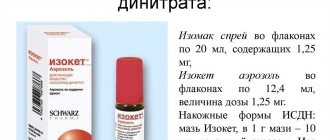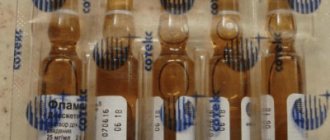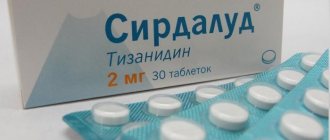Prohibited during pregnancy
Prohibited during breastfeeding
Not suitable for children
Can be taken by older people
Has limitations for liver problems
Has limitations for kidney problems
Many patients suffer from high blood cholesterol. This pathology is often associated with an unhealthy lifestyle and excessive consumption of fatty foods. Hypercholesterolemia disrupts the normal functioning of the entire body, promotes the development of atherosclerosis, and therefore cardiovascular pathologies.
Therefore, doctors recommend taking medications that can reduce the concentration of harmful lipids. Among them, Simvastol is especially popular.
Release form and composition
The dosage form of Simvastol is film-coated tablets: round, biconvex, white tablet core with a uniform structure, pink shell (dose 10 mg), yellow (dose 20 mg) or brown (dose 40 mg) (14 pcs. per blister, in a cardboard box 1 or 2 blisters).
1 film-coated tablet contains:
- active ingredient: simvastatin – 10, 20 or 40 mg;
- auxiliary components: pregelatinized starch, lactose monohydrate, ascorbic acid, microcrystalline cellulose PH101, butylated hydroxyanisole, citric acid monohydrate, magnesium stearate;
- film shell pink/yellow/brown: Opadry II 33G24737 (lactose monohydrate, hypromellose, titanium dioxide, glycerol triacetate, macrogol, red iron oxide dye, black iron oxide dye, aluminum varnish based on indigo carmine dye)/Opadry II 39G22514 (triacetin, hypromellose , titanium dioxide, macrogol, lactose monohydrate, iron oxide yellow, iron oxide red, iron oxide black)/Opadry II 33G26729 (titanium dioxide, macrogol, hypromellose, iron oxide yellow, glycerol triacetate, iron oxide red, lactose monohydrate, iron oxide black dye).
Similar means
To replace the drug Simvastol for one reason or another, its analogues are used. They can be structural (they contain the same active substance) and agents that are similar in their mechanism of action. Doctors often prescribe:
- Zokor. A popular remedy from the Netherlands. The active substance is simvastatin. Cost – from 160 to 320 rubles.
- Simvahexal. Structural analogue of Simvastol. Produced by a German pharmaceutical company. Sold at a price of 280-340 rubles.
- Basil. An effective lipid-lowering agent that contains simvastatin. Country of origin: Slovenia. The price of the medicine is 250-550 rubles.
- Simvastatin. Domestic drug. Its cost is from 52 to 95 rubles.
Only the attending physician can prescribe any medications or replace them with similar ones. Self-medication leads to negative consequences.
See also:
Using Simvastatin without a doctor's prescription
Pharmacological properties
Pharmacodynamics
Simvastol is a hypolipidemic drug of artificial origin, which is obtained from a fermentation product of Aspergillus terreus. Simvastatin, the active substance of the drug, is an inactive lactone and is metabolized in the body to form a hydroxy acid derivative. The active metabolite inhibits the action of 3-hydroxy-3-methyl-glugaryl-CoA reductase (HMG-CoA reductase), the enzyme responsible for the conversion of HMG-CoA to mevalonate. This process is an early stage of cholesterol synthesis.
Treatment with simvastatin does not lead to the accumulation of potentially toxic sterols in the body. During metabolic processes, HMG-CoA is easily converted into acetyl-CoA, which is involved in many synthesis processes in the body.
Simvastatin causes a decrease in plasma concentrations of triglycerides, low-density lipoproteins (LDL), very low-density lipoproteins (VLDL) and total cholesterol (this is true for cases of heterozygous non-familial and familial hypercholesterolemia, as well as mixed hyperlipidemia, when elevated cholesterol levels are considered risk factor).
Simvastol increases the level of high-density lipoprotein (HDL) and reduces the ratio of total cholesterol/HDL and LDL/HDL. The first results of treatment become noticeable 2 weeks after starting to take the drug, and the maximum therapeutic effect is observed after 4–6 weeks. The effect of Simvastol continues during regular therapy; after its discontinuation, the cholesterol concentration gradually returns to its original values.
Pharmacokinetics
Absorption of simvastatin in the body is quite high. After oral administration, maximum plasma levels occur after approximately 1.3-2.4 hours, decreasing by 90% after 12 hours. The substance binds to plasma proteins by approximately 95%.
Simvastatin is metabolized in the liver, there is a “first pass” effect through the liver, which consists in the hydrolysis of the compound to form the active metabolite - beta-hydroxy acid. Other active and inactive derivatives have also been identified. The half-life of active metabolites is 1.9 hours. Simvastatin is excreted mainly in feces (60%) in the form of metabolites. Approximately 10-15% is excreted in the urine in an inactive form.
What analogues of Simvastatin are present on the Russian market?
Structural substitutes for this drug include:
Actalipid;- Simvacard;
- Zorstat;
- Kholvasim;
- Simvor;
- Zokor;
- Syncard.
The following medications have a similar effect:
- Atorvastatin;
- Rosuvastatin;
- Lovasterol;
- Pravastatin;
- Kholvasim.
Indications for use
- hypercholesterolemia: primary (types IIa and IIb) in patients with an increased risk of developing coronary atherosclerosis in the absence of the effect of non-drug treatments, such as low-cholesterol diets, exercise and weight loss; in combination with hypertriglyceridemia, which cannot be corrected by diet therapy and physical activity;
- coronary heart disease: prevention of myocardial infarction, reducing the risk of death, slowing the progression of coronary artery atherosclerosis, reducing the risk of revascularization, reducing the risk of stroke, transient ischemic attacks and other cardiovascular disorders.
Contraindications
- myopathy;
- active phase of liver disease, sustained increase in the activity of liver enzymes of unknown etiology;
- hereditary lactose intolerance;
- history of hypersensitivity to other HMG-CoA reductase inhibitors (statin drugs);
- period of pregnancy and breastfeeding;
- children and adolescents up to 18 years of age;
- individual intolerance to the components of the drug.
It is recommended to prescribe Simvastol with caution for: chronic alcoholism; simultaneous therapy with immunosuppressants after organ transplantation (increased risk of renal failure and rhabdomyolysis); a history of liver disease; decreased or increased skeletal muscle tone, unknown etiology; epilepsy; conditions that contribute to the development of severe renal dysfunction, such as arterial hypotension, severe acute infectious diseases, severe metabolic and endocrine disorders, water and electrolyte imbalance, trauma and surgical interventions (including dental surgeries).
Indications and contraindications
There are special indications for taking the drug. Among them:
- Primary hypercholesterolemia. It affects patients diagnosed with coronary atherosclerosis. At the same time, patients are at risk of developing severe heart pathologies.
- Combined hypercholesterolemia.
- Hypertriglyceridemia.
In the case of such pathologies, medicine is prescribed only if other methods of therapy have not helped - a special diet that helps lower lipid levels and a set of exercises aimed at losing weight.
Also among the indications are various cardiovascular pathologies (for example, cardiac ischemia). The drug may be prescribed for:
- prevention of possible development of a heart attack;
- reducing the risk of patient death;
- reducing the risk of stroke or ischemic attacks;
- reducing the risk of performing a procedure to restore myocardial perfusion (revascularization);
- slowing the progression of atherosclerotic lesions of the coronary arteries.
Atherosclerosis
The drug has its contraindications and limitations. It should not be taken in the following conditions:
- individual intolerance to one or more components that make up the medicine;
- increased sensitivity to statins;
- pathology of skeletal muscles (myopathy);
- severe liver disease;
- increased activity of liver enzymes of unknown origin.
It should also be borne in mind that the drug is not used to treat the following categories of the population:
- Children and adolescents until they reach adulthood. No studies have been conducted among this group, so it is unknown what the consequences of using the drug may be.
- Pregnant women. If women of reproductive age take Simvastol, then reliable methods of contraception should be used. If pregnancy occurs, the drug should be discontinued immediately.
- Nursing mothers. The active substance may pass into breast milk and harm the baby. Therefore, if it is necessary to take simvastatin, breastfeeding should be stopped.
There are some restrictions under which the medicine is used with extreme caution. Among them:
- low blood pressure;
- various injuries and operations;
- alcohol addiction;
- impaired muscle tone, pain of unknown etiology;
- disturbances in liver function;
- disturbed electrolyte balance;
- metabolic and endocrine diseases;
- infectious diseases in the acute stage;
- internal organ transplantation, after which the use of immunosuppressants is indicated;
Immunosuppressive drugs
- disorders of the kidneys.
The medicine has contraindications that should be taken into account before prescribing it. In some conditions it is taken with caution.
See also:
Instructions for use of the drug Lipantil® and reviews about it
Instructions for use of Simvastol: method and dosage
Simvastol tablets are taken orally, 1 time per day in the evening, with a sufficient amount of water, at different times with meals.
Before starting therapy, the patient is prescribed a standard hypocholesterol diet, which he must follow throughout the course of treatment.
The doctor prescribes the dose and period of use of the drug individually.
Recommended dosage of Simvastol:
- hypercholesterolemia: the initial dose is 10 mg for 4 weeks, then, if necessary, the dose can be increased to 20 mg, in most cases it is optimal. The selection of a clinically effective dose is carried out by increasing the previous dose by 10 mg with an interval of 4 weeks, but not higher than 80 mg;
- homozygous hereditary hypercholesterolemia: 1 time per day in the evening - 40 mg or 80 mg in 3 divided doses (20 mg in the morning and afternoon, and 40 mg in the evening);
- coronary heart disease (treatment and prevention): initial dose – 20 mg for 4 weeks, then, taking into account the clinical course of the disease, the dose can be gradually, at intervals of 4 weeks, increased to 40 mg. Patients with low-density lipoprotein (LDL) levels below 75 mg/dL and total cholesterol levels below 140 mg/dL require a dose reduction.
For mild to moderate renal failure and elderly patients, no dose adjustment is required.
In case of simultaneous administration of verapamil or amiodarone, the daily dose of Simvastol should be no more than 20 mg.
In severe chronic renal failure with creatinine clearance (CC) below 30 ml/min and/or concomitant therapy with danazol, cyclosporine, gemfibrozil or other fibrates (except fenofibrate), nicotinic acid in lipid-lowering doses (1 g per day or higher) is recommended do not exceed the daily dose of simvastatin more than 10 mg.
Analogues of Simvastol
Level 4 ATX code matches:
Akorta
Atomax
Lipitor
Pravastatin
Owencore
Simgal
Tulip
Lovastatin
Liptonorm
Rozulip
Zokor
Rosart
Tevastor
Liprimar
Simvastatin
Atoris
Basilip
Rosecard
Roxera
Rosuvastatin
Drugs with similar therapeutic effects include: Atherostat , Vasilip , Avestatin , Vero-Simvastatin , Actalipid, Zocor forte , Zovatin , Levomir , Ovencor , Zocor , Simvahexal , Zorstat , Simvacor , Simvastatin , Simvacard , Simlo , Sincard , Simvor , Simplacor , Simgal , Kholvasim and others.
Side effects
- from the digestive system: nausea, vomiting, possible abdominal pain, diarrhea, constipation, pancreatitis, flatulence, increased activity of liver transaminases, creatine phosphokinase (CPK), alkaline phosphatase, hepatitis;
- from the nervous system: disturbance of taste, headache, insomnia, asthenic syndrome, dizziness, muscle cramps, peripheral neuropathy, paresthesia, blurred vision;
- from the musculoskeletal system: weakness, muscle cramps, myopathy, myalgia; rarely - rhabdomyolysis;
- allergic reactions: urticaria, fever, shortness of breath, lupus-like syndrome, angioedema, vasculitis, arthritis, polymyalgia rheumatica;
- dermatological reactions: skin hyperemia, photosensitivity; rarely – skin itching, rash, dermatomyositis, alopecia;
- laboratory parameters: increased ESR (erythrocyte sedimentation rate), thrombocytopenia, eosinophilia;
- other: anemia, palpitations, hot flashes, decreased potency; against the background of rhabdomyolysis – acute renal failure.
Overdose
Cases of Simvastol overdose known to specialists (the maximum dose taken was 450 mg) were not accompanied by the manifestation of specific symptoms. Gastric lavage and activated charcoal are recommended as treatment. Symptomatic therapy is also prescribed and the level of CPK in the blood serum and kidney and liver function are constantly monitored.
If the patient develops myopathy with rhabdomyolysis and acute renal failure (a severe but rare side effect), it is necessary to discontinue the drug and administer sodium bicarbonate and a diuretic to the patient via intravenous infusion. If necessary, hemodialysis is performed.
Rhabdomyolysis can provoke hyperkalemia, which is eliminated by the use of potassium ion exchangers, intravenous administration of calcium gluconate or calcium chloride, glucose infusion with the addition of insulin, or in particularly severe cases through hemodialysis.
Similar drugs:
- Choludexan Capsule
- Niacin (Niacyne) Substance-powder
- Ursosan Capsule
- Dialipon Capsule
- Neurolipon Capsule
- Guarem Dosed microgranules
- Ursorom C Capsule
- Dialipon Solution for infusion
- Liprimar Oral tablets
- Lipamide Oral tablets
** The Drug Directory is intended for informational purposes only. For more complete information, please refer to the manufacturer's instructions. Do not self-medicate; Before starting to use the drug Simvastol, you should consult a doctor. EUROLAB is not responsible for the consequences caused by the use of information posted on the portal. Any information on the site does not replace medical advice and cannot serve as a guarantee of the positive effect of the drug.
Are you interested in the drug Simvastol? Do you want to know more detailed information or do you need a doctor's examination? Or do you need an inspection? You can make an appointment with a doctor - the Euro lab is always at your service! The best doctors will examine you, advise you, provide the necessary assistance and make a diagnosis. You can also call a doctor at home . Euro lab clinic is open for you around the clock.
** Attention! The information presented in this medication guide is intended for medical professionals and should not be used as a basis for self-medication. The description of the drug Simvastol is provided for informational purposes and is not intended for prescribing treatment without the participation of a doctor. Patients need to consult a specialist!
If you are interested in any other drugs and medications, their descriptions and instructions for use, information about the composition and form of release, indications for use and side effects, methods of use, prices and reviews of drugs, or you have any other questions and suggestions - write to us, we will definitely try to help you.
special instructions
According to the instructions, Simvastol should not be prescribed to patients with an increased risk of developing rhabdomyolysis and renal failure. Risk factors for these pathologies include an acute form of severe infection, arterial hypotension, planned major surgery, trauma, and severe metabolic disorders.
The use of the drug is not indicated for hypertriglyceridemia types I, IV and V.
Treatment with Simvastol should be accompanied by monitoring of liver function. Studies of liver enzyme activity are carried out before starting to use the drug and regularly during therapy: 2 times every 6 weeks, then every 8 weeks until the end of the first year, then once every six months. A liver function test should be performed at each dose increase, and at a daily dose of 80 mg, every 12 weeks. A transient increase in liver enzyme levels is possible at the beginning of therapy. If transaminase activity exceeds 3 times the initial level and maintains a steady increase, the pills should be discontinued.
For patients with hypothyroidism and/or kidney disease (including nephrotic syndrome) with elevated cholesterol levels, it is recommended that the underlying disease be treated first.
In addition to monotherapy, the use of the drug is indicated in combination with bile acid sequestrants.
It is recommended to avoid simultaneous consumption of large quantities (more than 250 ml) of grapefruit juice, since the severity of side effects of simvastatin may be increased.
With the use of Simvastol, the development of myopathy, rhabdomyolysis and renal failure is possible. Symptoms of these pathologies include the appearance of muscle soreness, unexplained pain, lethargy or muscle weakness, accompanied by general malaise or fever. The risk of developing myopathy increases with simultaneous use of fibrates (fenofibrate, gemfibrozil), nefazodone, cyclosporine, macrolides (clarithromycin, erythromycin), HIV protease inhibitors (ritonavir), and azole antifungals (itraconazole, ketoconazole). In addition, the likelihood of developing myopathy is higher in patients with severe renal failure. When prescribing the drug, the doctor must warn the patient about the possibility of this disease, its symptoms and the need to immediately contact a specialist if they develop.
In patients with suspected or diagnosed myopathy, Simvastol should be discontinued.
Patients of childbearing age should use reliable contraception during the entire period of taking the drug. If pregnancy occurs during treatment, the drug should be stopped, and the woman should be warned about the possible risk to the fetus.
Cancellation of lipid-lowering drugs during pregnancy does not significantly affect the result of long-term therapy for primary hypercholesterolemia.
If myalgia, myasthenia gravis and/or a marked increase in CPK activity occurs, the use of Simvastol should be discontinued.
If you accidentally miss the next dose, it should be taken as soon as you remember, provided that this does not mean taking two doses at the same time.
In case of severe renal failure, treatment should be carried out by monitoring renal function.
The patient must follow a cholesterol-lowering diet before starting therapy and during the entire period of taking Simvastol.
The effect of the drug on the patient’s ability to drive vehicles and machinery has not been established.
Simvastol®
Muonatia/ Rhabdomyolysis
Simvastatin, like other statins, can cause myopathy, which manifests itself as muscle pain, soreness or weakness and is accompanied by an increase in CPK activity (more than 10 times the ULN). Myopathy may manifest itself in the form of rhabdomyolysis, sometimes accompanied by secondary acute renal failure due to myoglobinuria. In rare cases, death has occurred. The risk of developing myopathy increases with increasing plasma concentrations of substances that have an inhibitory effect on HMG-CoA reductase. Risk factors for developing myopathy include older age (65 years or older), female gender, uncontrolled hypothyroidism, and impaired renal function.
As with treatment with other HMG-CoA reductase inhibitors, the risk of developing myopathy/rhabdomyolysis is dose dependent. IN
In clinical studies of simvastatin (median follow-up duration was 4 years), the incidence of myopathy when using doses of 20 mg, 40 mg and 80 mg per day was 0.03%, 0.08% and 0.61%, respectively. In these studies, patients were closely monitored and a number of drugs that may interact with simvastatin were not used.
In a clinical study in which patients with a history of myocardial infarction were treated with simvastatin 80 mg daily (mean follow-up 6.7 years), the incidence of myopathy was approximately 1.0%, and in patients treated with simvastatin 20 mg daily day - 0.02%. Approximately half of the cases of myopathy were reported during the first year of treatment. The incidence of myopathy during each subsequent year of treatment was approximately 0.1%.
In patients taking simvastatin at a dose of 80 mg per day, the risk of developing myopathy is higher than when using other statins that cause a comparable decrease in LDL cholesterol concentrations. Therefore, the drug Simvastol® at a dose of 80 mg per day should be prescribed only
patients with a high risk of cardiovascular complications, in whom drug therapy at lower doses did not achieve the desired therapeutic effect, and the expected benefit of treatment outweighs the possible risk. If a patient taking Simvastol® at a dose of 80 mg requires treatment with another drug that may interact with simvastatin, then it is necessary to reduce the dose of Simvastol® or prescribe another statin that has less potential for possible drug interactions (see sections "Contraindications" and "Method of administration and dosage").
All patients who begin drug therapy
Simvastol®
, as well as patients who need to increase their dose, should be warned about the possibility of myopathy and informed about the need to immediately consult a doctor if any unexplained muscle pain, muscle soreness or muscle weakness occurs.
Therapy with Simvastol
should be discontinued immediately if myopathy is suspected or diagnosed.
The presence of the above symptoms and/or a more than 10-fold increase in CPK activity compared to ULN indicates the presence of myopathy. In most cases, after immediate cessation of taking Simvastol, the symptoms of myopathy resolve and CPK activity decreases. In patients starting to take Simvastol® or switching to higher doses of the drug, periodic determination of CPK activity is advisable, but there is no guarantee that such monitoring can prevent the development of myopathy.
Many patients who experienced rhabdomyolysis during simvastatin therapy had a complicated medical history, including impaired renal function, usually due to diabetes mellitus. Such patients require more careful monitoring. Therapy with Simvastol® should be temporarily discontinued several days before major surgical interventions, as well as in the postoperative period.
In a clinical study in which patients at high risk for cardiovascular disease received simvastatin 40 mg once daily (median follow-up 3.9 years), the incidence of myopathy was approximately 0.24% in Chinese patients and 0.05 % among patients of other nationalities. Although the only Mongoloid patients in this clinical study were Chinese, caution should be exercised when prescribing simvastatin to Mongoloid patients, particularly at low doses.
The risk of developing myopathy/rhabdomyolysis increases with simultaneous use of the drug
Simvastol®
with the following medications.
Contraindicated drug combinations
- Potent inhibitors of the
CYP3A4 isoenzyme 4.
CYP3A4 isoenzyme at therapeutic doses (for example,
itraconazole, ketoconazole, posaconazole, voriconazole, erythromycin, clarithromycin, telnthromycin, HIV protease inhibitors, boceprevir, telaprevir, nefazodo, or drugs containing cobici stat)
contraindicated. If short-term treatment with potent inhibitors of the CYP3A4 isoenzyme cannot be avoided, therapy with Simvastol* should be interrupted for the period of their use (see sections “Contraindications” and “Interaction with other drugs”).
— Gemfibrozil, cyclosporine or danazol.
The simultaneous use of these drugs with Simvastol® is contraindicated (see sections “Contraindications” and “Interaction with other drugs”).
Other medicines
— Other fibrates. In patients taking fibrates other than gemfibrozil
(see section "Contraindications")
or fenofibrate, the dose of simvastatin should not exceed 10 mg per day.
With simultaneous use of simvastatin and fenofibrate, the risk of developing myopathy does not exceed the sum of the risks when treating each drug separately. Fenofibrate should be used with caution in combination with simvastatin, as both drugs can cause the development of myopathy. The addition of fibrate therapy to simvastatin therapy usually leads to a small additional decrease in LDL cholesterol concentrations, but allows for a more pronounced decrease in TG concentrations and an increase in HDL cholesterol concentrations. In small short-term clinical studies in which both drugs were used under close supervision, combination therapy with fibrates and simvastatin was not associated with the development of myopathy (see section "Interactions with other drugs").
— Amiodarone. In patients taking amiodarone, the dose of simvastatin should not exceed 20 mg per day.
(see section “Interaction with other drugs”).
— Blockers of "slow" calcium channels. In patients taking verapamil, diltiazem or amlodipine, the dose of simvastatin should not exceed 20 mg per day
(see section “Interaction with other drugs”).
— Lomitapide. In patients with homozygous seminal hypercholesterolemia taking lomitapide, the dose of simvastatin should not exceed 40 mg per day
(see section “Interaction with other drugs”).
— Moderate inhibitors of the
CYP3A4 isoenzyme 4.
With simultaneous use of drugs with moderate inhibitory activity against the CYP3A4 isoenzyme and simvastatin, especially in higher doses, the risk of developing myopathy may increase . When simvastatin is used concomitantly with moderate inhibitors of the CYP3A4 isoenzyme, a dose adjustment of simvastatin may be required.
— Fusidic acid.
Concomitant use of fusidic acid and simvastatin may increase the risk of developing myopathy (see section "Interaction with other drugs"). The simultaneous use of simvastatin and fusidic acid is not recommended. If the use of systemic fusidic acid preparations is considered necessary, the drug Simvastol® should be discontinued for the period of this therapy. In exceptional cases, when long-term therapy with systemic fusidic acid preparations is necessary, for example, for the treatment of severe infections, the possibility of simultaneous use of Simvastol and fusidic acid should be considered individually in each individual case and combination therapy should be carried out under close medical supervision.
— Nicotinic acid (in lipid-lowering doses of at least 1 g/day).
With the simultaneous use of the drug Simvastol* and nicotinic acid in lipid-lowering doses (at least 1 g/day), cases of the development of myopathy/rhabdomyolysis have been described.
In a clinical trial (median follow-up 3.9 years) in patients at high cardiovascular risk with well-controlled LDL-C concentrations, simvastatin 40 mg/day with or without ezetimibe 10 mg/day showed no additional positive effect on the outcomes of cardiovascular diseases with simultaneous use of nicotinic acid in lipid-lowering doses (at least 1 g/day). Thus, the benefit of simultaneous use of simvastatin with nicotinic acid in lipid-lowering doses (at least 1 g/day) should be carefully weighed against the potential risks of combination therapy. Additionally, in this study, the incidence of myopathy was approximately 0.24% among Chinese patients treated with simvastatin 40 mg or simvastatin/ezetimibe 40 mg/10 mg, compared with 1.24% among Chinese patients treated with simvastatin at a dose of 40 mg or simvastatin/ezetimibe at a dose of 40 mg/10 mg simultaneously with laropiprant/nicotinic acid sustained release at a dose of 40 mg/2 g . Although in this clinical study the only representatives of the Mongoloid race were Chinese patients, The simultaneous use of simvastatin with nicotinic acid in lipid-lowering doses (at least 1 g/day) in patients of the Mongoloid race is not recommended, since the incidence of myopathy is higher in patients of Chinese nationality than in patients of other nationalities
(see section “Interaction with other drugs” ).
Effect on the liver
Some adult patients taking simvastatin experienced sustained increases in liver enzyme activity (more than 3 times the ULN). When simvastatin therapy was discontinued or interrupted, hepatic transaminase activity usually gradually returned to baseline levels. Increased activity of liver transaminases was not associated with jaundice or other clinical symptoms. No hypersensitivity reactions were identified. Some of the above patients had abnormal liver function tests before starting treatment with simvastatin and/or abused alcohol.
Before starting treatment, and then in accordance with clinical indications, liver function tests are recommended in all patients. Patients in whom it is planned to increase the dose of Simvastol® to 80 mg per day should undergo additional liver function tests before proceeding to the specified dosage, then 3 months after the start of its use and then repeat regularly (for example, once every six months ) during the first year of treatment. Particular attention should be paid to patients with increased activity of “liver” transaminases. These patients need to repeat liver function tests in the near future and then regularly until the activity of “liver” transaminases normalizes. In cases where the activity of “liver” transaminases increases, especially when the ULN is persistently exceeded by 3 times, the drug should be discontinued. The cause of increased alanine aminotransferase (ALT) activity may be muscle damage, so increased ALT and CPK activity may indicate the development of myopathy (see section "Special Instructions", Myopathy/Rhabdomyolysis).
There have been rare post-marketing reports of fatal and non-fatal cases of liver failure in patients taking statins, including simvastatin. If severe liver damage with clinical symptoms and/or hyperbilirubinemia or jaundice develops during treatment with Simvastol®, therapy should be discontinued immediately. If no other cause for the development of this pathology has been identified, re-prescribing Simvastol® is contraindicated.
In patients who abuse alcohol and/or patients with impaired liver function, the drug should be used with extreme caution. Active liver disease or an unexplained increase in the activity of liver transaminases are contraindications to the use of Simvastol®.
During treatment with Simvastol®, as with treatment with other lipid-lowering drugs, a moderate (less than 3 times the ULN) increase in the activity of “liver” transaminases was observed. These changes appeared soon after the start of treatment, were often transient, were not accompanied by any symptoms and did not require interruption of treatment.
Ophthalmological examination
Data from modern long-term clinical studies do not contain information regarding the adverse effects of simvastatin on the human lens.
Use in children and adolescents aged 10-17 years
The safety and effectiveness of simvastatin in children and adolescents aged 10-17 years with heterozygous familial hypercholesterolemia were assessed in controlled clinical studies involving boys 10-17 years old and girls 10-17 years old at least 1 year after menarche. In pediatric patients receiving simvastatin, the adverse event profile was comparable to that of patients receiving placebo. Use of the drug
Simvastol®
at a dose of more than 40 mg per day has not been studied in pediatric and adolescent patients.
In this study, there was no significant effect of simvastatin on the growth and puberty of boys and girls or any effect on the length of the menstrual cycle in girls. Girls should be advised about proper methods of contraception during treatment with Simvastol® (see sections “Contraindications” and “Use during pregnancy and breastfeeding”). The use of simvastatin has not been studied in children under 10 years of age or in girls 10–17 years of age before menarche.
Use in elderly patients
In patients over the age of 65 years, the effectiveness of simvastatin, assessed by the level of reduction in the concentration of total cholesterol and LDL cholesterol, was similar to the effectiveness observed in the general population. There was no significant increase in the frequency of adverse events or changes in laboratory parameters. However, in a clinical study of simvastatin 80 mg daily, patients over 65 years of age had an increased risk of developing myopathy compared with patients under 65 years of age.
Drug interactions
The increased risk of developing myopathy is influenced by the simultaneous use of cytostatics, fibrates, immunosuppressants, nefazodone, erythromycin, clarithromycin, azole antifungals, HIV protease inhibitors, high doses of nicotinic acid, telithromycin, in addition, with high doses of simvastatin - cyclosporine, danazol, amiodarone, verapamil, diltiazem.
The bioavailability of simvastatin is reduced by colestipol and cholestyramine, therefore, with concomitant therapy, to achieve an additive effect, Simvastol should be taken no earlier than 4 hours after these drugs.
The drug increases the level of digoxin in the blood plasma.
Simvastatin increases the effect of oral anticoagulants (including phenprocoumon, warfarin) and the risk of bleeding, therefore, before starting combination treatment, it is necessary to determine the patient's blood clotting parameters and regularly monitor them during the initial period of therapy. After achieving a stable level of prothrombin time, they switch to a standard anticoagulant treatment regimen. When changing the dose of the drug or stopping its use, the above scheme for monitoring prothrombin time should be used.
When used as monotherapy, Simvastol does not affect laboratory parameters of prothrombin time or increase the risk of bleeding.
Grapefruit juice significantly increases the inhibitory activity against HMG-CoA reductase in blood plasma.











